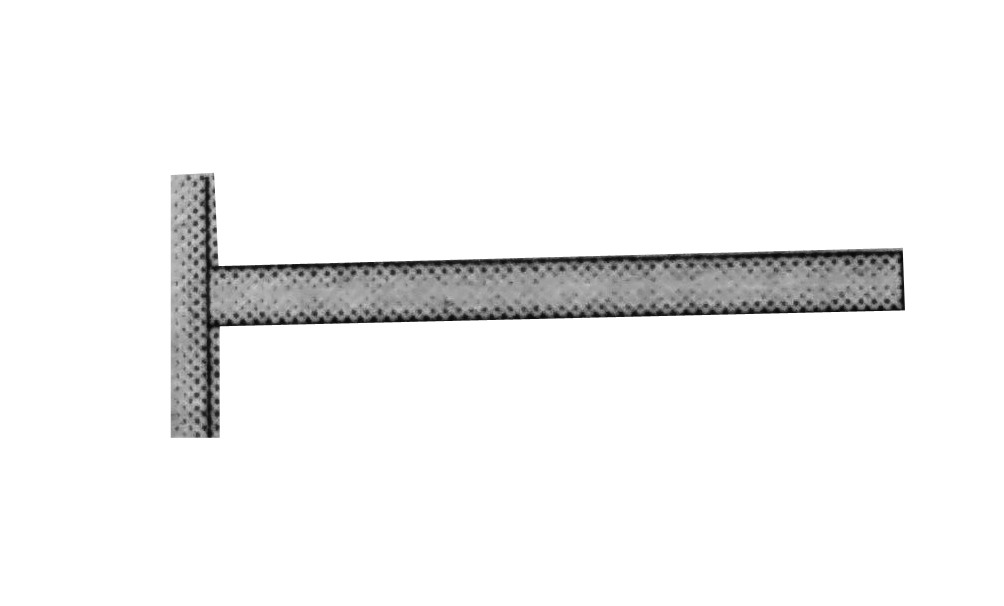A rod of length l and radius r is joined to a rod of length l/2 and radius r/2 of same material. The free end of small rod is fixed to a rigid base and the free end of larger rod is given a twist of θ∘, the twist angle at the joint will be
θ/4
θ/2
5θ/6
8θ/9
The correct Answer is:D
To solve the problem, we need to find the twist angle at the joint of two rods made of the same material. We have a larger rod of length l and radius r joined to a smaller rod of length l2 and radius r2. The free end of the larger rod is twisted by an angle θ, and we want to determine the twist angle at the joint, which we will denote as θ0.
1. Identify the Torque Relationship:
The torque τ developed in a rod due to twisting is given by:
τ=C⋅θ
where C is the torsional rigidity of the rod and θ is the twist angle.
2. Torsional Rigidity:
The torsional rigidity C for a circular rod is given by:
C=πnr42l
where n is the modulus of rigidity, r is the radius, and l is the length of the rod.
3. Torque for the Larger Rod:
For the larger rod (length l, radius r):
τ1=πnr42l⋅θ
4. Torque for the Smaller Rod:
For the smaller rod (length l2, radius r2):
τ2=πn(r2)42⋅l2⋅θ0=πnr416l⋅θ0
5. Equating the Torques:
Since both rods are joined and experience the same torque, we set τ1=τ2:
πnr42l⋅θ=πnr416l⋅θ0
6. Canceling Common Terms:
We can cancel πnr4 and l from both sides:
12⋅θ=116⋅θ0
7. Solving for θ0:
Rearranging gives:
θ0=8⋅θ
8. Finding the Relation:
From the previous steps, we can express θ in terms of θ0:
θ=98⋅θ0
Thus, we can substitute back to find θ0:
θ0=89⋅θ
Final Answer:
The twist angle at the joint θ0 is:
θ0=89θ
The torque τ developed in a rod due to twisting is given by:
τ=C⋅θ
where C is the torsional rigidity of the rod and θ is the twist angle.
The torsional rigidity C for a circular rod is given by:
C=πnr42l
where n is the modulus of rigidity, r is the radius, and l is the length of the rod.
For the larger rod (length l, radius r):
τ1=πnr42l⋅θ
For the smaller rod (length l2, radius r2):
τ2=πn(r2)42⋅l2⋅θ0=πnr416l⋅θ0
Since both rods are joined and experience the same torque, we set τ1=τ2:
πnr42l⋅θ=πnr416l⋅θ0
We can cancel πnr4 and l from both sides:
12⋅θ=116⋅θ0
Rearranging gives:
θ0=8⋅θ
From the previous steps, we can express θ in terms of θ0:
θ=98⋅θ0
Thus, we can substitute back to find θ0:
θ0=89⋅θ
The twist angle at the joint θ0 is:
θ0=89θ
Topper's Solved these Questions
- ELASTICITYBOOK - ERRORLESS CHAPTER - ELASTICITYEXERCISE - Work done in stretching a wire
30 Videos
- ELASTICITYBOOK - ERRORLESS CHAPTER - ELASTICITYEXERCISE - Critical Thinking
8 Videos
- ELASTICITYBOOK - ERRORLESS CHAPTER - ELASTICITYEXERCISE - Bulk Modulus
21 Videos
- FLUID MECHANICSBOOK - ERRORLESS CHAPTER - FLUID MECHANICSEXERCISE - Fluid Mechanics
19 Videos
Similar Questions
Knowledge Check
Two ends of rods of length L and radius R of the same material of kept at the same temperature. Which of the following rods conducts the maximum heat?
AL=50 cm, R = 1 cmBL = 100cm, R = 2 cmCL = 25 cm, R = 0.5 cmDL = 75 cm , R = 1.5 cmA large cylindrical rod of length L is made by joining two identical rods of copper and steel of length (L2) each. The rods are completely insulated from the surroundings. If the free end of copper rod is maintained at 100∘C and that of steel at 0∘C then the temperature of junction is (Thermal conductivity of copper is 9 times that of steel)
A90∘CB50∘CC10∘CD67∘CA 2m long rod of radius 1 cm which is fixed from one end is given a twist of 0.8 radians the shear strain developed will be
A0.002B0.004C0.008D0.016
A rod of length l is released from the vertical position on a smooth horizontal plane. What is the nature of motion of the free end of the rod ?
View SolutionTwo rods of different materials and identical cross sectional area, are joined face to face at one end their free ends are fixed to the rigid walls. If the temperature of the surroundings is increased by 30∘C, the magnitude of the displacement of the joint of the rod is (length of rods l1=l2=1unit, ratio of their young's moduli, Y1/Y2=2, coefficients of linear expansion are α1 and α2)
View Solution
In the given figure, a rod is free at one end and other end is fixed. When we change the temperature of rod by Δθ, then strain produced in the rod will be
View SolutionTwo wires A and B of same length and of the same material have the respective radii r1 and r2. Their one end is fixed with a rigid support, and at other end equal twisting couple is applied. Then the ratio of the angle of twist at the end of A and the angle of twist at the end of B will be
View SolutionA 2 m long rod of radius 1 cm which is fixed from one end is given a twist of 0.8 radius. The shear strain developed will be
View Solution
